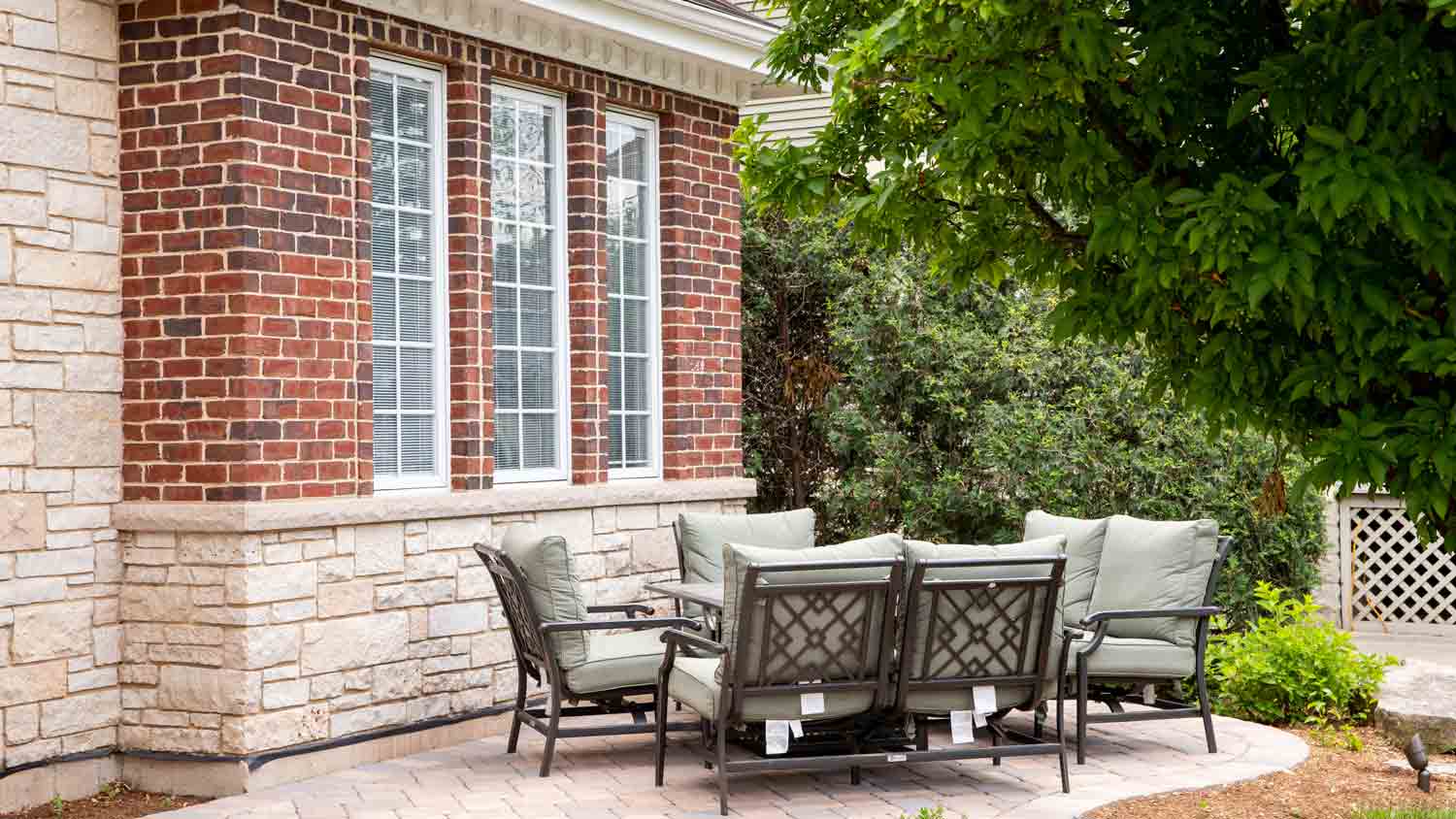
Discover the average stone restoration cost, including price ranges and key factors, to help you plan your next home project with confidence.
Flagstone comes in many forms and has become a go-to choice for jaw-dropping exteriors
Flagstone isn’t a type of stone, it’s a blanket term for flat rocks used in landscaping.
It can be used for patios, walkways, driveways, roof shingles, and more.
Bluestone and slate are two popular types of flagstone.
Flagstone costs an average of $2 to $6 per square foot.
It’s tough to turn your outdoor space into a year-round party pad if your yard is on the plainer side. Bare patches of grass, after all, are not especially inviting. Your best bet is to hire a professional landscaper to discuss alternatives, but what are your options? One of the most popular landscaping choices in recent years is to lay down flagstone to form walkways, patios, and more. Flagstone is strong, extremely versatile, and looks fantastic. But what, exactly, is it?
Flagstone is not a type of stone; it’s a blanket term referring to many different types of rocks. The term refers to the size and shape of the rocks, as flagstone breaks from larger pieces of stone into flat sheets of varying thickness. A stonemason turns many different rock types into flagstone, including sandstone, shale, limestone, quartzite, marble, granite, basalt, and others. Flagstone can be relatively soft if made from sedimentary rocks, or incredibly tough if made from igneous or metamorphic rocks.
Flagstone gives an outdoor space a pleasing rustic look, bringing with it many uses. Flagstone patios have become a popular choice in recent years, as have flagstone walkways. Flagstone is also tough enough to withstand the weight of an automobile, so many homeowners opt for flagstone driveways instead of boring, old concrete. Some roofers even use flagstone to make shingles. In other words, this is a highly versatile material.

As previously mentioned, flagstone is a catch-all term referring to any number of rocks that flake into flat sheets. Flagstone breaks down into two types: patio flagstone and select/stand-up flagstone. Patio flagstone is typically on the smaller side (about 12 to 18-inches around).
These smaller pieces make for great walkways, stepping stones, and, of course, patios. Next, select flagstone, otherwise known as stand-up flagstone, is slightly thicker and much larger, with a circumference of 18 to 36-inches. Select flagstone pieces are for stacking, making them an excellent option for wall caps, countertops, and other applications.
However, there are numerous types of flagstone for primarily aesthetic value.
This type of flagstone—primarily made of sandstone—features a distinctive rough-textured look and comes in a full range of colors, from pale sand to dark red. Even cooler? Some sandstone flagstone pieces include stray plant and animal fossils.
Known for its superior durability, quartzite flagstone is the perfect option for heavily trafficked areas. A stonemason mixes sandstone and quartz to create quartzite flagstone. It comes in a wide array of color options, from silver and gold to green and blue.
Colorado red flagstone stands up well to harsh weather, so it’s an excellent choice for areas with either scorching summers or frigid winters. As the name suggests, the colors range from red to purple.
Bluestone flagstone is highly resistant to freezing temperatures, though it does not stand up too well to saltwater. It boasts a natural non-slip finish, making it a great choice for poolside areas. Bluestone comes in various shades of blue and gray.
There are several unique advantages to flagstone that make it a desired paving choice.
Flagstone comes in nearly every color of the rainbow, with naturally occurring patterns to add a truly distinctive look to your renovation project. You can mix and match types for unique and breathtaking color schemes. The sheer variety of available types ensures that each flagstone project has its own look and feel.
Most flagstone types are easy to install, as a qualified pro lays it directly on top of a layer of sand or gravel. This is dry-laid flagstone. Some homeowners opt for mortared flagstone, which lays in a bed of mortar. Mortared flagstone is more labor-intensive than dry-laid flagstone, but makes up for the extra effort with increased durability and longevity.
Flagstone is just thin slabs of stone, making them incredibly versatile; you can use flagstone all over your property for entirely different purposes. It’s an excellent option for both indoors and outdoors, after all.
Most types of flagstone are naturally slip-resistant, which is why they show up so regularly as walkways and surrounding poolsides. Flagstone also tends to resist freeze-thaw cycles, upping its durability. Most flagstone installations should last 30 years with proper care and maintenance.
Flagstone is not perfect, and it does carry some unique disadvantages.
Thinner pieces of flagstone can break if you aren’t careful. Softer flagstone types, such as sedimentary rocks, are particularly prone to breaking. If you lay down flagstone to form a heavily trafficked walkway or a driveway, ensure the rocks are thick enough to stand up to abuse.
If your flagstone pieces do break, it’s often a challenge to source an exact replacement. Flagstone is naturally occurring and minimally processed, so quarries produce pieces that vary in color, design, and thickness. If you are looking for replacement pieces, reach out to the stonemason who sourced your original pieces.
You should regularly clean and seal your flagstone to ensure a long lifespan. Sealant helps the flagstone repel water and helps to fill in any pores. Apply a sealant once every year. As for cleaning, outdoor flagstone can get dirty easily, ruining the material’s natural elegance. Clean the flagstone twice a year with a vinegar-based solution or a flagstone cleaning solution.
Bluestone is a type of flagstone. Because it is sedimentary rock formed by particles from rivers, oceans, and lakes, it often has a blueish or gray tint. Bluestone is known for its sturdiness, but it is also porous and therefore requires more frequent cleaning. Expect to spend between $375 to $450 per ton for bluestone.
Slate is another type of flagstone, and one of the best-known varieties. It has a smooth appearance, so it lends a more uniform look to walkways, patios, and other outdoor projects. It’s also very durable, making it an excellent choice for areas with heavy foot traffic. The cost for slate runs $475 to $700 per ton.
Flagstone is relatively affordable, though the cost of flagstone varies, depending on the type of rocks used. This material costs $2 to $6 per square foot, though you should also account for labor at $13 to $16 per square foot. These labor costs can add up, especially with a large project, such as building an entire patio. The cost of a flagstone patio ranges from $750 to $8,400, depending on square footage, installation type, and materials needed.
From average costs to expert advice, get all the answers you need to get your job done.

Discover the average stone restoration cost, including price ranges and key factors, to help you plan your next home project with confidence.

The cost to brick a house depends on several factors, like labor costs, home size, and brick types. Use our guide to estimate your bricking costs.

The cost to replace brick front steps depends on the type of brick, square footage, pattern, and more. Learn how much you may spend on this project.

Review this list of questions to ask when hiring a masonry contractor for home projects.

You can hire a professional to fix a decaying brick wall, or you can save money and do it yourself by learning how to tuckpoint brick using the steps below.

Discover the common masonry problems that can harm stone or brick surfaces at your home. While some masonry issues can be fixed with DIY solutions, anything involving brick replacement should be done by a professional.